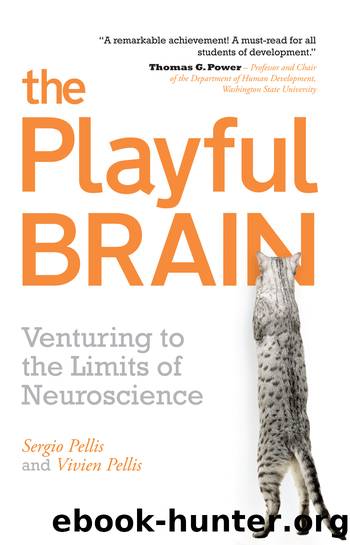The Playful Brain by Sergio Pellis & Vivien Pellis

Author:Sergio Pellis & Vivien Pellis
Language: eng
Format: epub
Publisher: Oneworld Publications
Published: 2013-10-01T00:00:00+00:00
Figure 6.1 A mother bonobo is shown lying on her back and using her feet to hold her infant overhead. From this position, the mother can jostle and shake the infant, providing it with visual, tactile and vestibular stimulation. (Adapted from a photograph by Frans Lanting. © 2008, Frans Lanting/www.lanting.com)
In our model, motherâinfant play in primates provides an additional layer to the complexity of the behavior of typical, mammalian motherâinfant interactions. Such motherâinfant primate play may have, at first, been limited to more gentle versions of the species-typical play fighting seen in peerâpeer interactions. In some lineages, however, this play may have been enhanced by incorporating forms of playful interaction that bear little to no resemblance to the species-typical pattern of play fighting as described above for great ape mothers. If we are correct, then it is apparent what infants gain from this early play, but what are the origins of this behavior in mothers?
It is likely that primates began as nocturnal, solitary living, arboreal animals. Some primates alive today have maintained this lifestyle: the lorises and pottos of Asia and Africa.35 Unlike rodents and many other small nocturnal mammals, lorises, like other primates, give birth to one, or occasionally two, babies, at a time. A free-living loris mother âparksâ her baby in some safe location when she goes off to forage, and then returns to the baby to tend to its needs. The infant, therefore, has little to no opportunity to encounter other infants. This means that, if play fighting is a necessary part of growing up, then it either has to be the mother with whom they play, or nothing. Thus, the peer-deprived youngster, if it were to have any experience of play, would have to direct playful overtures to its mother. But why should she respond? At a functional level, her playful counter-response makes sense because by doing so, she would provide her offspring with essential, developmental experiences, and this would enhance her offspringâs chances of success in surviving and later reproducing. This does not, however, explain the mechanisms that propel her to play with her infant in the first place.
Adultâadult play fighting is quite common in primates and one context in which it is frequently used is in courtship behavior. The use of play fighting in courtship is particularly prevalent in primates whose social systems lead to infrequent or sporadic encounters with members of the opposite sex â that is, sex that occurs between unfamiliar animals (see chapter 5). You can see the direction in which this argument is going. The lorises and their kin have social systems that make adultâadult contact infrequent, and yes, they have well-developed and frequent adultâadult play fighting. Indeed, the adults are so playful in some species that they play more with other adults than they do with youngsters.36 If these mothers already have a propensity for play, then that propensity may have aided them in responding to the playful overtures of their young. In this fashion, primates representing an early
Download
This site does not store any files on its server. We only index and link to content provided by other sites. Please contact the content providers to delete copyright contents if any and email us, we'll remove relevant links or contents immediately.
Governing Habits: Treating Alcoholism in the Post-Soviet Clinic by Eugene Raikhel(258)
TSRA Operative Dictations in Cardiothoracic Surgery by unknow(216)
Cardiology in a Heartbeat, second edition by Vaswani Amar;Khaw Hwan Juet;El-Medany Ahmed;Dougherty Scott;(194)
The Rosetta Stone of the Human Mind by Vincenzo R. Sanguineti(190)
The Trauma Chronicles by Westaby Stephen(163)
If Joan of Arc Had Cancer : Finding Courage, Faith, and Healing from History's Most Inspirational Woman Warrior by Janet Lynn Roseman(159)
How Selegiline ((-)-Deprenyl) Slows Brain Aging by Joseph Knoll(157)
Lymphedema (Lymph Obstruction), a Simple Guide to the Condition, Diagnosis, Treatment and Related Conditions by Kenneth Kee(156)
Clinical Nephrology - 2020 by Weber MD C. G(153)
The Heart Health Bible by John M. Kennedy(152)
Dear Millie: Diary of a seven year old with cancer by Marco Previero(145)
Community Engagement, Organization, and Development for Public Health Practice by Murphy Frederick;Frederick Murphy Msphyg Mpia;(143)
Fast Facts: Skin Cancer by unknow(140)
Restful Insomnia by Sondra Kornblatt(137)
Rethinking Evidence in the Time of Pandemics: Scientific vs Narrative Rationality and Medical Knowledge Practices by Eivind Engebretsen Mona Baker(136)
Home and Dry by Birgit Bulla(135)
Fibromyalgia--Your Treatment Guide by Christine Craggs-Hinton(130)
What Your Doctor May Not Tell You About Cholesterol by Stephen R. Devries & Winifred Conkling(129)
The Plague of 1665 by Emma Laybourn(125)
